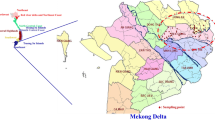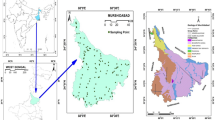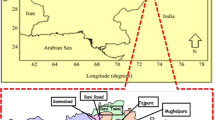Abstract
Groundwater in the central part of Argentina contains arsenic concentrations that, in most cases, exceed the value suggested by international regulations. In this region, Quaternary loessical sediments with a very high volcanic glass fraction lixiviate arsenic and fluoride after weathering. The objectives of this study are to analyze the spatial distribution of arsenic in different hydrogeological regions, to define the naturally expected concentration in an aquifer by means of hydrogeochemistry studies, and to identify emergent health evidences related to cancer mortality in the study area. The correlation between arsenic and fluoride concentrations in groundwater is analyzed at each county in the Cordoba Province. Two dimensionless geoindicators are proposed to identify risk zones and to rapidly visualize the groundwater quality related to the presence of arsenic and fluoride. A surface-mapping system is used to identify the spatial variability of concentrations and for suggesting geoindicators. The results show that the Chaco-Pampean plain hydrogeologic region is the most affected area, with arsenic and fluoride concentrations in groundwater being generally higher than the values suggested by the World Health Organization (WHO) for drinking water. Mortality related to kidney, lung, liver, and skin cancer in this area could be associated to the ingestion of arsenic-contaminated water. Generated maps provide a base for the assessment of the risk associated to the natural occurrence of arsenic and fluoride in the region.








Similar content being viewed by others
References
Abernathy, C. O., Liu, Y. P., Longfellow, D., Aposhian, H. V., Beck, B., Fowler, B., et al. (1999). Arsenic: Health effects, mechanisms of actions, and research issues. Environmental Health Perspectives, 107(7), 593–597. doi:10.2307/3434403.
Bates, M. N., Rey, O. A., Biggs, M. L., Hopenhayn Rich, C., Moore, L. E., Kalman, D., et al. (2004). Case–control study of bladder cancer and exposure to arsenic in Argentina. American Journal of Epidemiology, 159(4), 381–389. doi:10.1093/aje/kwh054.
Berger, A. R. (1997). Assessing rapid environmental change using geoindicators. Environmental Geology, 32(1), 36–44. doi:10.1007/s002540050191.
Bergoglio, R. M. (1963). Mortalidad por cáncer en zona de aguas arsenicales de la provincia de Córdoba (República Argentina). In Paper presented at the V Congreso Ibero-Latinoamericano de Dermatología, Buenos Aires.
Bhattacharya, P., Claesson, M., Bundschuh, J., Sracek, O., Fagerberg, J., Jacks, G., et al. (2006). Distribution and mobility of arsenic in the Río Dulce alluvial aquifers in Santiago del Estero Province, Argentina. Science of the Total Environment, 358, 97–120. doi:10.1016/j.scitotenv.2005.04.048.
de Marsily, G. (1986). Quantitative hydrogeology: Groundwater hydrology for engineers. Orlando, Florida: Academic Press.
Francisca, F. M. (2007). Evaluating the constrained modulus and collapsibility of loess from standard penetration test. ASCE International Journal of Geomechanics, 7(4), 307–310. doi:10.1061/(ASCE)1532-3641(2007)7:4(307).
Francisca, F. M., Redolfi, E. R., & Prato, C. A. (2002). Análisis de tuberías enterradas en suelos loéssicos: efecto de la saturación del suelo. Revista Internacional de Desastres Naturales Accidentes e Infraestructura Civil, 2(2), 3–19.
García, M. G., Moreno, C., Fernandez, D. S., Galindo, M. C., Sracek, O., & Hidalgo, V. M. (2006). Intermediate to high levels of arsenic and fluoride in deep geothermal aquifers from the northwestern Chacopampean Plain, Argentina. In Paper presented at the conference on Natural Arsenic in Groundwaters of Latin America, Mexico City.
Giedraitiene, J., Satkunas, J., Graniczny, M., & Doktor, S. (2002). The chemistry of groundwater: A geoindicator of environmental change across the Polish–Lithuanian border. Environmental Geology, 42(7), 743–749. doi:10.1007/s00254-002-0555-6.
Guo, H.-R., & Tseng, Y.-C. (2000). Arsenic in drinking water and bladder cancer: Comparison between studies based on cancer registry and death certificates. Environmental Geochemistry and Health, 22, 83–91. doi:10.1023/A:1006759002674.
Hopenhayn-Rich, C., Biggs, M. L., & Smith, A. H. (1998). Lung and kidney cancer mortality associated with arsenic in drinking water in Cordoba, Argentina. International Journal of Epidemiology, 27, 561–569. doi:10.1093/ije/27.4.561.
Instituto Nacional de Estadísticas y Censos. (2001). Censo Nacional de Población, Hogares y Viviendas. Argentina: Resultados generales Cordoba.
Karlsson, A. (1993). Método mineralógico para la tipificación numérica de sedimentos loéssicos. Revista de Geología Aplicada a la Ingeniería y al Ambiente, 7, 199–204.
Krige, D. G. (1978). Lognormal-de Wijsian geostatistics for ore evaluation (geostatistics). Johannesburg: South African Institute of Mining and Metallurgy.
Kröhling, D. M. (1999). Sedimentological maps of the typical loessic units in North Pampa, Argentina. Quaternary International, 62(1), 49–55. doi:10.1016/S1040-6182(99)00022-1.
Marengo, E., Gennaro, M. C., Robotti, E., Maiocchi, A., Pavese, G., Indaco, A., et al. (2008). Statistical analysis of ground water distribution in Alessandria Province (Piedmont—Italy). Microchemical Journal, 88, 167–177. doi:10.1016/j.microc.2007.11.011.
Nicolli, H. B., Suriano, J. M., Gómez Peral, M. A., Ferpozzi, L. H., & Baleani, O. A. (1989). Groundwater contamination with arsenic and other trace elements in an area of the Pampa, Province of Cordoba, Argentina. Environmental Geology, 14, 3–16.
Obras Sanitarias de la Nación. (1942). El problema del agua potable en el interior del país: Tomo II Análisis Químicos. Buenos Aires: Ministerio de Obras Públicas.
Paoloni, J. D., Sequeira, M. E., & Fiorentino, C. E. (2005). Mapping of arsenic content and distribution in groundwater in the Southeast Pampa, Argentina. Journal of Environmental Health, 67(8), 51–53.
Rapport, D., & Friend, A. (1979). Towards a comprehensive framework for environmental statistics: A stress–response approach. Statistics Canada Catalogue 11-510. Ottawa: Minister of Supply and Services Canada.
Rocca, R. J., Redolfi, E. R., & Terzariol, R. E. (2006). Características geotécnicas de los loess de Argentina. Revista Internacional de Desastres Naturales Accidentes e Infraestructura Civil, 6(2), 3–19.
Santa Cruz, J. N., & Silva Busso, A. (1999). Escenario hidrogeológico General de los Principales Acuíferos de la Llanura Pampeana y Mesopotamia Meridional Argentina. In Paper presented at the II Congreso Argentino de Hidrogeología, Santa Fe.
Sayago, J. M., Collantes, M. M., Karlson, A., & Sanabria, J. (2001). Genesis and distribution of the Late Pleistocene and Holocene loess of Argentina: A regional approximation. Quaternary International, 76/77, 247–257. doi:10.1016/S1040-6182(00)00107-5.
Schulz, C. J., Castro, E. C., & Mariño, E. (2005). Presencia de Arsénico en las Aguas Subterráneas de la Pampa. In Paper presented at the IV Congreso Hidrogeológico Argentino, Río Cuarto.
Smedley, P. L., & Kinniburgh, D. G. (2002). A review of the source, behaviour and distribution of arsenic in natural waters. Applied Geochemistry, 17(5), 517–568. doi:10.1016/S0883-2927(02)00018-5.
Smedley, P. L., Kinniburgh, D. G., Macdonald, D. M. J., Nicolli, H. B., Barros, A. J., Tullio, J. O., et al. (2005). Arsenic associations in sediments from the loess aquifer of La Pampa, Argentina. Applied Geochemistry, 20, 989–1016. doi:10.1016/j.apgeochem.2004.10.005.
Smith, A. H., Hopenhayn-Rich, C., Bates, M. N., Goeden, H. M., Hertz-Picciotto, I., Duggan, H. M., et al. (1992). Cancer risks from arsenic in drinking water. Environmental Health Perspectives, 97, 259–267. doi:10.2307/3431362.
Smith, A. H., Arroyo, A. P., Mazumder, D. N. G., Kosnett, M. J., Hernandez, A. L., Beeris, M., et al. (2000). Arsenic-induced skin lesions among Atacameño people in Northern Chile despite good nutrition and centuries of exposure. Environmental Health Perspectives, 108(7), 617–620. doi:10.2307/3434881.
Teruggi, M. E. (1957). The nature and origin of Argentine loess. Journal of Sedimentary Petrology, 27, 323–332.
Tricart, J. (1969). Actions éoliennes dans la Pampa Deprimida. Revue de Géomorphologie Dynamique, 4, 178–189.
Wu, M. M., Kuo, T. L., Hwang, Y. H., & Chen, C. J. (1989). Dose–response relation between arsenic concentration in well water and mortality from cancers and vascular diseases. American Journal of Epidemiology, 130, 1123–1132.
World Health Organization. (2006). Guidelines for drinking-water quality: incorporating first addendum (Vol. 1, Recommendations, 3rd ed.). Geneva.
Zárate, M. A. (2003). Loess of southern South America. Quaternary Science Reviews, 22(18–19), 1987–2006. doi:10.1016/S0277-3791(03)00165-3.
Acknowledgments
The authors thank CONICET and SECYT for their support in this research.
Author information
Authors and Affiliations
Corresponding author
Rights and permissions
About this article
Cite this article
Francisca, F.M., Carro Perez, M.E. Assessment of natural arsenic in groundwater in Cordoba Province, Argentina. Environ Geochem Health 31, 673–682 (2009). https://doi.org/10.1007/s10653-008-9245-y
Received:
Accepted:
Published:
Issue Date:
DOI: https://doi.org/10.1007/s10653-008-9245-y




